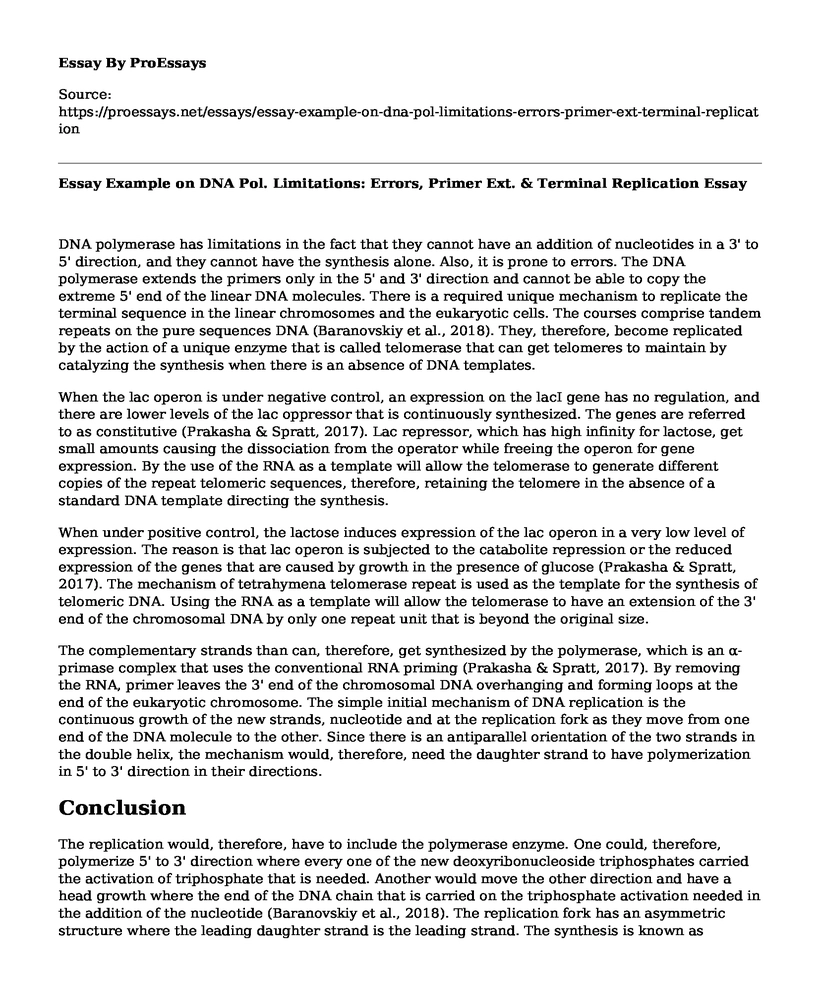DNA polymerase has limitations in the fact that they cannot have an addition of nucleotides in a 3' to 5' direction, and they cannot have the synthesis alone. Also, it is prone to errors. The DNA polymerase extends the primers only in the 5' and 3' direction and cannot be able to copy the extreme 5' end of the linear DNA molecules. There is a required unique mechanism to replicate the terminal sequence in the linear chromosomes and the eukaryotic cells. The courses comprise tandem repeats on the pure sequences DNA (Baranovskiy et al., 2018). They, therefore, become replicated by the action of a unique enzyme that is called telomerase that can get telomeres to maintain by catalyzing the synthesis when there is an absence of DNA templates.
When the lac operon is under negative control, an expression on the lacI gene has no regulation, and there are lower levels of the lac oppressor that is continuously synthesized. The genes are referred to as constitutive (Prakasha & Spratt, 2017). Lac repressor, which has high infinity for lactose, get small amounts causing the dissociation from the operator while freeing the operon for gene expression. By the use of the RNA as a template will allow the telomerase to generate different copies of the repeat telomeric sequences, therefore, retaining the telomere in the absence of a standard DNA template directing the synthesis.
When under positive control, the lactose induces expression of the lac operon in a very low level of expression. The reason is that lac operon is subjected to the catabolite repression or the reduced expression of the genes that are caused by growth in the presence of glucose (Prakasha & Spratt, 2017). The mechanism of tetrahymena telomerase repeat is used as the template for the synthesis of telomeric DNA. Using the RNA as a template will allow the telomerase to have an extension of the 3' end of the chromosomal DNA by only one repeat unit that is beyond the original size.
The complementary strands than can, therefore, get synthesized by the polymerase, which is an α-primase complex that uses the conventional RNA priming (Prakasha & Spratt, 2017). By removing the RNA, primer leaves the 3' end of the chromosomal DNA overhanging and forming loops at the end of the eukaryotic chromosome. The simple initial mechanism of DNA replication is the continuous growth of the new strands, nucleotide and at the replication fork as they move from one end of the DNA molecule to the other. Since there is an antiparallel orientation of the two strands in the double helix, the mechanism would, therefore, need the daughter strand to have polymerization in 5' to 3' direction in their directions.
Conclusion
The replication would, therefore, have to include the polymerase enzyme. One could, therefore, polymerize 5' to 3' direction where every one of the new deoxyribonucleoside triphosphates carried the activation of triphosphate that is needed. Another would move the other direction and have a head growth where the end of the DNA chain that is carried on the triphosphate activation needed in the addition of the nucleotide (Baranovskiy et al., 2018). The replication fork has an asymmetric structure where the leading daughter strand is the leading strand. The synthesis is known as continuously the leading strand. It, therefore, preceded the synthesis of the daughter strand and referred to as the lagging strand. The direction of the nucleotide polymerization is the opposite of the overall direction in the DNA growth chain.
References
Baranovskiy, A. G., Duong, V. N., Babayeva, N. D., Zhang, Y., Pavlov, Y. I., Anderson, K. S., & Tahirov, T. H. (2018). Activity and fidelity of human DNA polymerase α depend on primer structure. Journal of Biological Chemistry, 293(18), 6824-6843. http://www.jbc.org/content/293/18/6824.full.pdf
Prakasha Gowda, A. S., & Spratt, T. E. (2017). Active site interactions impact phosphoryl transfer during replication of damaged and undamaged DNA by Escherichia coli DNA Polymerase I. Chemical research in toxicology, 30(11), 2033-2043. https://dx.doi.org/10.1021%2Facs.chemrestox.7b00257
Cite this page
Essay Example on DNA Pol. Limitations: Errors, Primer Ext. & Terminal Replication. (2023, Aug 29). Retrieved from https://proessays.net/essays/essay-example-on-dna-pol-limitations-errors-primer-ext-terminal-replication
If you are the original author of this essay and no longer wish to have it published on the ProEssays website, please click below to request its removal:
- Paper Example on Banning Horse-Drawn Carriages From the Street of New York City
- Keeping Animals in Zoos Should Be Banned for Life - Essay Sample
- Research Paper on Endangered Species Act
- Otters: Endangered Carnivorous Semiaquatic Mammals - Research Paper
- Captive Tigers: An Unsustainable Population in the US - Research Paper
- Illegal Pet Trade: Smuggling & Abuse of Adored Pets - Essay Sample
- Paper Example on Hyaline Cartilage







